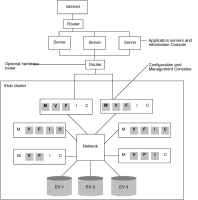Clustering : About distributing services to a cluster About distributing services to a cluster
You can control the configuration of a cluster and each node in a cluster, including:

iHub services and settings

Services and settings for a cluster node

Cluster membership
You can enable one or more services in each server template.
In a cluster, you can use templates to configure the nodes instantiated in an iHub System, as shown in
Figure 9‑2. Each node is a computer running iHub, configured through the template definitions stored in acserverconfig.xml, which is accessible by all nodes through a shared directory. The following letters represent the available services in
Figure 9‑2:

M is the Message Distribution service.

V is the View service.

F is the Factory service.

I is the Integration service.

C is the Caching service.
Figure 9‑2 An iHub cluster configuration
A letter in a gray box represents an enabled service. The other letters represent disabled services. When you enable or disable a service in a template, the cluster nodes that use different templates can have different functionality.
Two nodes have the Message Distribution service enabled in the cluster in the preceding example. In the example, the two machines share one virtual IP address to communicate with the router.
Information Console or iHub perform load balancing independent of load‑balancing capabilities in the router. All requests to the iHub cluster go to one of the two redirector nodes, which are the nodes with the Message Distribution service enabled. The redirector nodes dispatch the requests to other nodes in the cluster based on message type and cluster load.
The configuration file, acserverconfig.xml, located in a shared location provides centralized management of the cluster configuration through the use of server templates and other parameters. A server template is a set of parameters that specifies the configuration properties of a node or set of nodes.
The acpmdconfig.xml file for each node, located in the AC_SERVER_HOME/etc directory on the node machine, has its <AC_CONFIG_HOME> element set to point to the location for the shared acserverconfig.xml file. The <AC_TEMPLATE_NAME> element specifies which template the node uses.
One or more nodes in the cluster manage request message routing. The Message Distribution service uses HTTP to communicate between nodes in a cluster. An iHub cluster supports multicast network communication.
